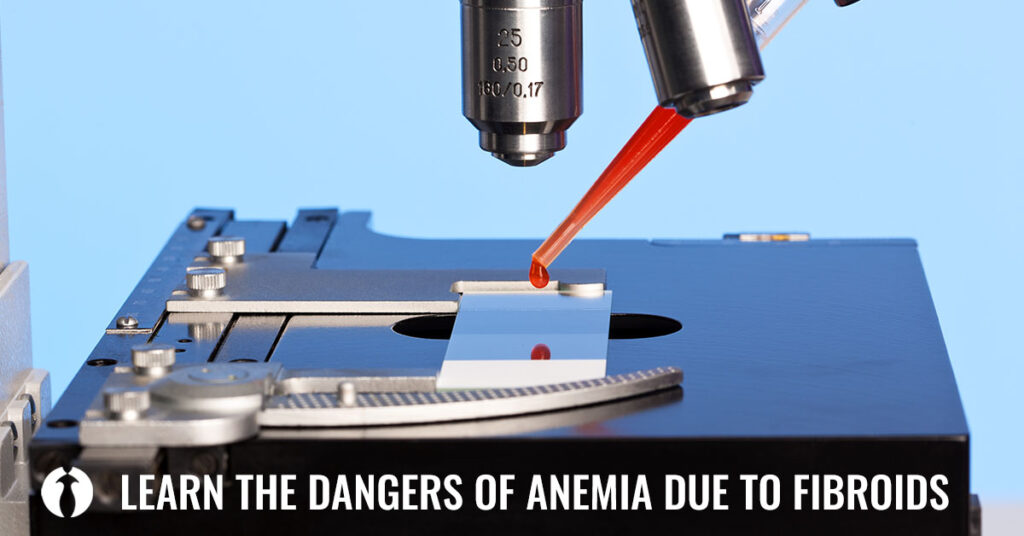- January 22, 2021
Learn the Dangers of Anemia Due to Fibroids

Heavy bleeding from GYN conditions such as fibroids and adenomyosis can cause anemia. A simple blood test can confirm anemia, and if you are anemic, it is important to monitor your symptoms and seek treatment if they worsen.
Anemia can worsen over time as fibroids grow or adenomyosis gets worse. Treatment for these underlying conditions is necessary to reduce the heavy menstrual bleeding that leads to anemia.
The Dangers of Anemia
Knowing the dangers of anemia can help women get ahead of potentially life-threatening complications such as congestive heart failure, angina, arrhythmia and heart attack.
Loss of blood is the most common cause of anemia. In addition to the loss of red blood cells from the body, which your bone marrow must replace, loss of iron contained in these cells will ultimately lead to iron deficiency once tissue stores have been depleted. Iron deficiency associated with chronic bleeding leads to a reduced bone marrow response, worsening the degree of anemia.
Your body needs iron to make a protein called hemoglobin. This protein carries oxygen, which is essential for tissue and muscles to function effectively. When there isn’t enough iron in the blood stream, the rest of the body can’t get the amount of oxygen it needs.
Anemia symptoms vary depending on the cause of your anemia but may include:
- Fatigue
- Weakness
- Pale skin
- A fast or irregular heartbeat
- Shortness of breath
- Chest pain
- Dizziness
- Cognitive problems
- Cold hands and feet
- Headache
Approximately 25% of women of reproductive age have absent iron stores, meaning any amount of bleeding can result in anemia. Iron deficiency in the United States and Western Europe is almost always due to blood loss.
Extreme pain during your period is not normal. We can help you find relief from painful periods.
| Find Relief Today |
| Call 888-787-4379 |
Abnormal GYN Bleeding Due to Fibroids
Fibroids within the uterine lining (submucosal) can cause severe bleeding, even if they are small. These fibroids can increase the area of the lining and the amount of menstrual bleeding, and they can decrease the ability of the lining to stop the bleeding.
Fibroids within the uterine muscle (intramural) that are larger or close to the cavity will increase blood flow to the uterus and affect the systems that control bleeding in the uterus. These fibroids will also increase the size of the cavity of the uterus, thereby increasing bleeding.
Increased bleeding in the uterine cavity due to these types of fibroids can result in the formation of clots. Pain is caused by distension of the womb and passage of the clots. Many women pass very large clots and have extreme pain with their menstrual cycle as a result.
Relief from heavy bleeding due to fibroids is possible with a minimally invasive procedure. Talk through your options with a CIGC patient advocate today.
| Talk to a Patient Advocate |
| Call 888-787-4379 |
Thorough Fibroid Removal Is Essential For Long-Term Relief
Thoroughly removing fibroids from the uterus can only be performed by a highly skilled minimally invasive GYN surgeon. Fibroids that are very small or located deep in the muscle can be hard to find unless they are felt and removed by a skilled hand. If fibroids are not removed, they will continue to grow and cause problems with heaving bleeding, pelvic pain and infertility. Standard laparoscopic or robotic techniques do not allow a surgeon to feel the fibroids, meaning some may be left behind to continue to grow and prolong symptoms.
Fibroid removal surgery can be performed as a myomectomy, removing the fibroids while leaving the uterus intact, or as a hysterectomy, removing the fibroids along with the uterus. A myomectomy is performed for women who wish to retain the ability to get pregnant. A hysterectomy for fibroid removal is performed for women who suffer from recurring fibroids and no longer wish to become pregnant. Depending on your future plans for fertility, it is important to find a surgeon who will work with you as a partner. CIGC specialists perform both procedures through advanced minimally invasive techniques known as LAAM and DualPortGYN.
The LAAM (Laparoscopically Assisted Abdominal Myomectomy) procedure is a minimally invasive fibroid removal technique that allows the surgeon to safely and effectively remove all of the fibroids at any location in or around the uterus. Surgeons skilled in this technique are able to feel all fibroids no matter their size by using their hands to manipulate the uterus and identify fibroids deep in the muscle of the uterus that cannot be easily seen.
A hysterectomy is the most effective way to eliminate fibroids, and the DualPortGYN hysterectomy is one of the most minimally invasive GYN surgery techniques available. Once the uterus is removed, fibroids cannot regrow. It is important to understand what a hysterectomy entails and to choose a highly skilled minimally invasive GYN surgeon who will explain in detail what will happen during and after the surgery.
Book A Consultation
GYN surgical specialists can often see women sooner because they are focused entirely on surgery. Each patient gets detailed, in-depth attention from Dr. Natalya Danilyants and Dr. Paul MacKoul. This personalized care helps patients understand their condition and the recommended treatment so they can have confidence from the very start. Our surgeons have performed over 25,000 GYN procedures and are constantly finding better ways to improve outcomes for patients.
Book a consultation today with Dr. Paul MacKoul, MD or Dr. Natalya Danilyants, MD.
REVIEWS
Dr. Paul MacKoul Reviews
Dr. Natalya Danilyants Reviews
CIGC TRAVEL PROGRAM
Many patients travel to The Center for Innovative GYN Care for our groundbreaking procedures. We have treated women from around the world and in 30 countries who suffer from complex GYN conditions. Learn more about our travel program.
- Read the full article:
- Posted in: GYN Surgery, Fibroids, Abnormal Bleeding








